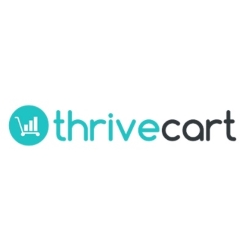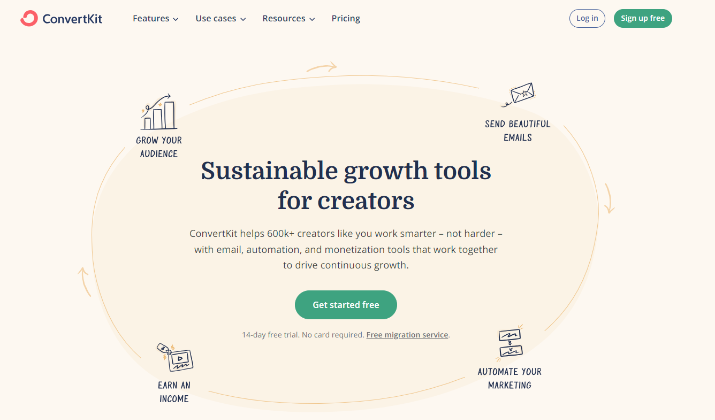ThriveCart is a powerful, user-friendly ecommerce platform that helps businesses sell products and services online with features like customizable checkout pages, payment processing, sales funnels, and affiliate management.
On the other side, ConvertKit is an email marketing platform designed for creators, offering features such as visual automation builders, customizable sign-up forms and landing pages, and unlimited broadcasts and campaigns.
When considering ThriveCart and ConvertKit for your online business, it’s crucial to understand what do they offer and what are they used for. This is in addition to knowing about their features, pricing, and other things.
In this article, we will review the two platforms which will help you decide which platform to go with as per your needs.
Lets’s dive in!
Overview
ThriveCart
ThriveCart is a powerful shopping cart software designed for digital entrepreneurs.
It offers a simple and user-friendly interface, pre-designed templates for sales pages and funnels, and sales-boosting features like upsells, downsells, and order bumps.
ThriveCart integrates with various services, supports multiple payment options, and includes features like subscription management, affiliate programs, and sales tax calculation.
It is ideal for selling digital products like e-books, courses, and membership sites, but not suitable for physical products or complex ecommerce operations.
ThriveCart is known for its ease of use, high conversion rates, and affordable lifetime pricing, making it a popular choice for those looking to streamline their online sales process and maximize revenue.
Also read: ThriveCart vs SendOwl
Create high-converting cart pages, funnels, affiliate campaigns, courses and more.
ConvertKit
ConvertKit is an all-in-one email marketing platform designed specifically for online creators.
It offers a user-friendly interface and a variety of features to streamline your email marketing efforts. With ConvertKit, you can set up visual automations to deliver targeted, personalized emails to your subscribers.
The platform also provides a form builder, allowing you to create beautiful opt-in forms to capture leads and grow your email list.
ConvertKit’s integration capabilities make it easy to connect with other tools and platforms you use in your business.
Check out: ThriveCart vs 1ShoppingCart
Ease of Use
ThriveCart
ThriveCart offers a powerful shopping cart platform with extensive customization options, making it ideal for businesses that require complex checkout processes and detailed control over their sales funnels.
It has a steeper learning curve due to the sheer number of features and customization options available, which can be overwhelming for new users.
ThriveCart provides a lifetime access model with no monthly fees, which can be beneficial for businesses that want to avoid recurring costs.
ConvertKit
CobvertKit prioritizes simplicity and efficiency, focusing on ease of use and quick setup for landing pages and email marketing campaigns.
It offers a straightforward, no-frills approach to landing page creation, making it ideal for creators, bloggers, and small businesses that want to quickly deploy effective landing pages.
ConvertKit provides a range of pricing plans tailored to different user needs, including a free plan for up to 1,000 subscribers.
In short, ThriveCart is geared towards businesses that require advanced customization and control over their checkout processes, while ConvertKit is designed for users who value simplicity and ease of use in their landing page and email marketing efforts.
Explore: ThriveCart vs SureCart
Create high-converting cart pages, funnels, affiliate campaigns, courses and more.
Design & Customization
ThriveCart
ThriveCart offers more design flexibility, allowing users to extensively customize their checkout pages and sales funnels.
The platform provides a powerful, feature-rich editor that gives users control over every aspect of the design.
Additionally, ThriveCart provides a wide range of customization options, enabling users to create highly tailored checkout experiences. This includes the ability to add custom fields, create complex funnels, and integrate with various payment gateways.
ConvertKit
ConvertKit, on the other hand, prioritizes simplicity and efficiency in its landing page builder. While it offers customization options, the focus is on ease of use rather than granular design control.
It offers a more streamlined approach to customization, allowing users to adjust key elements like colors, fonts, and images without getting lost in the minutiae.
The platform provides a selection of pre-designed templates that are optimized for conversion.
As you can see, ThriveCart excels in design flexibility and customization options, making it suitable for businesses that require advanced control over their checkout process and sales funnels.
ConvertKit focuses on simplicity and efficiency, providing a user-friendly experience that is ideal for creators, bloggers, and small businesses looking to quickly deploy effective landing pages.
Read this too: 6 Best SamCart Templates
Integrating with Autoresponders
ThriveCart offers seamless integration with ConvertKit, allowing users to manage contacts for various triggers such as adding to tags, sequences, removing tags, and sequences.
This enables businesses to automate email marketing efforts based on customer behavior and purchase history.
Similarly, ConvertKit provides a user-friendly interface for integrating with ThriveCart, enabling businesses to connect their ConvertKit account with ThriveCart to utilize it within behavior rules.
This allows for the application of tags to customers based on their purchase history, triggering specific email sequences or segmenting the email list accordingly.
By connecting these two platforms, users can automate repetitive tasks, reduce manual effort, and achieve better collaboration between teams. It allows for the creation of automated processes that run in the background without manual intervention.
You might like this: ThriveCart vs Kajabi
Create high-converting cart pages, funnels, affiliate campaigns, courses and more.
Checkout Process
ThriveCart offers a streamlined checkout process with customizable checkout pages, one-click upsells and downsells, and affiliate management systems. This enables businesses to maximize revenue and enhance the customer experiencw.
ConvertKit does not directly handle checkout processes. Instead, it integrates with other tools like ThriveCart to automate email marketing efforts based on customer behavior and purchase history.
In brief, ThriveCart is designed for managing checkout processes and sales funnels, while ConvertKit focuses on email marketing automation and list building.
Both tools can be integrated to enhance the overall sales funnel experience and drive conversions.
Also read: SamCart vs ConvertKit
Customer Support & Resources
Let’s take a look at customer support options:
Support Options
ThriveCart offers support through email, but does not have a live chat option.
ConvertKit provides support through email, live chat, and a support page with detailed documentation.
Documentation & Tutorials
ThriveCart has a support page with detailed documentation, but it is not as extensive as ConvertKit’s resources.
ConvertKit offers comprehensive documentation, including tutorials, guides, and FAQs, making it easier for users to find answers to common questions.
Community & Forums
ThriveCart does not have a dedicated community or forum for users to interact and share knowledge.
ConvertKit has a community section where users can ask questions, share knowledge, and get help from other users and the ConvertKit team.
Check out: SamCart Review
Analytics & Optimization
Analytics
-
- ThriveCart provides detailed analytics that can help optimize your sales funnels. It tracks metrics like conversion rates, average order value, and customer lifetime value, giving you insights to improve your checkout process and increase revenue.
- ConvertKit offers advanced reporting and analytics features, including subscriber scoring, to help you understand your audience and optimize your email marketing campaigns. You can track metrics like open rates, click-through rates, and revenue generated from specific emails or automations.
A/B Testing
-
- ThriveCart allows you to test different versions of your product pages and checkout process to optimize for conversions. You can experiment with different headlines, images, and calls-to-action to see what resonates best with your audience.
- ConvertKit does not have built-in A/B testing capabilities for landing pages or emails. However, you can integrate with third-party tools like Optimizely or VWO to run A/B tests on your ConvertKit landing pages and emails.
Optimization Tools
-
- ThriveCart offers intelligent behavior rules and business insights to help you optimize your sales funnels. You can set up rules to trigger specific actions based on customer behavior, such as offering a discount to cart abandoners or upselling to high-value customers.
- ConvertKit provides visual automation builders and segmentation tools to help you optimize your email marketing campaigns. You can create complex automations based on subscriber behavior and interests, and segment your list to send highly targeted emails.
Explore: ThriveCart vs Hotmart
Create high-converting cart pages, funnels, affiliate campaigns, courses and more.
Conclusion
ThriveCart stands out for its robust features in optimizing the checkout process, maximizing revenue through upsells and downsells, and providing advanced customization options for sales funnels and affiliate campaigns.
Unlike ThriveCart, ConvertKit focuses on email marketing automation, audience segmentation, and personalized email campaigns, making it a valuable tool for email marketing.
You also have the option to avail the benefits of both. By integrating the two, businesses can create a seamless workflow, recover lost revenue, build relationships with subscribers, and grow their online presence.














